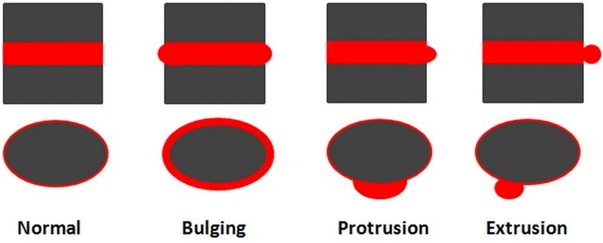What are spinal discs?
Spinal discs lie between each
of the vertebra that make up your spine. They provide
cushion to absorb shock when pressure is added to the spine.
The discs consist of two parts: the outer tougher layer
called the annulus fibrosis and the inner jelly-like
substance called the nucleus pulposis.
What are the most common
disc problems?

- A disc “bulge”
describes the symmetric bulging of the entire disc. It
happened as a result of a weakened annulus fibrosis.
This is a very common disc problem to arise and may or
may not cause pain.
- Disc protrusions
and extrusions are true disc herniations. This
occurs when the annulus fibrosis is completely or
significantly torn, allowing the inner gelatinous
material to leak out. Depending on the severity of the
herniation, the herniated material may press on the
nerves that exit the spine, or even the spinal cord.
This usually results in severe pain and can also cause
numbness, tingling, or weakness. If the spinal cord is
compressed symptoms may include loss of bowel or bladder
control, loss of feeling in both buttocks, legs, and/or
arms, inability to walk or use your arms, or fever
- Disc degeneration:
The nucleus pulposis is made mostly of water. As we
age, the water content decreases, therefore decreasing
the amount of “cushion” and support the disc can
provide. The disc becomes thinner and thinner until the
bones begin to grind against each other. The vertebrae
often form osteophytes or “bone spurs” as a result of
the added pressure on the bones themselves. This is how
osteoarthritis presents in the spine.
How are disc problems
treated?
- Most disc problems are
easily and successfully treated through conservative
care. Chiropractic care has been shown to be just as, if
not more, effective than surgery in treating disc
herniations. In addition to chiropractic adjustments, we
use a variety of therapeutic modalities to alleviate
pain.
- Chiropractic
adjustments are a safe and effective way to manage disc
problems, especially when combined with therapeutic
exercise. By adding motion to the spine and eliminating
any joint dysfunction, chiropractors facilitate the disc
in returning to its normal state.
- Staying as active as
possible (without overdoing it) is imperative to the
healing process. Keeping your spine moving is incredibly
beneficial and will help to get you back to your daily
activities sooner. By adding motion to your spine,
you’re increasing the amount of blood flow and nutrients
that the disc is receiving. Bed rest will not have this
effect and tends to increase stiffness.
- In most circumstances,
spine surgery and injections are not necessary. These
are usually only necessary in severe cases. We will
evaluate and examine your specific case thoroughly in
order to determine if you need to be referred out to
another specialist for pain management and if so, we
will coordinate care with that doctor and co-treat you
appropriately.
|